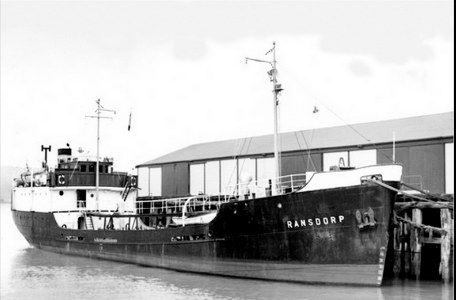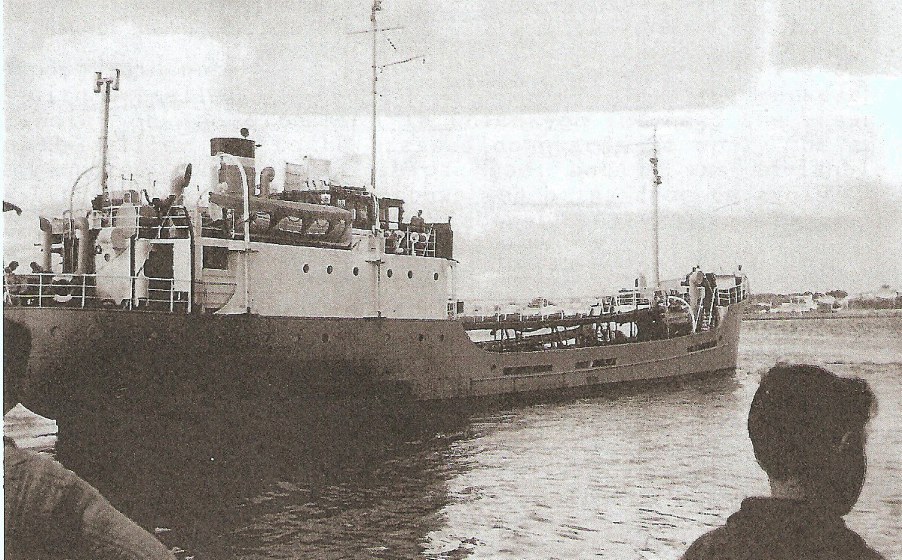The Ultimate New Zealand Soccer Website | home
Tainui | Takapu | Tangaroa | Taranui | Tarapunga | Tarihiko | Tasi | Taupata | Tawanui | Thor Star | Tiare Moana | Titoki | Titoki | Toa Moana | Totara | Totara | Towai | Turihaua | Union Nelson | Unitedgeo 1 | United Sailor | Unit Shipper | Verao | Vili | Viti | Waiotahi | Wellington Exporter | Western Spruce | Westport | Westport | Zephyr II
Verao
 Sourced from www.flotilla-australia.com
Photo shows vessel as "Ransdorp", prior to her time as "Verao"
|
||||||||||||||||||||
Built in Nederlandsche Dok, Amsterdam, as a tanker for G.T. Ketjen & Co., she is powered by a seven-cylinder, two-stroke diesel engine, producing a service speed of 9 knots. She was named after a village in the province of North Holland, and built as a dry cargo coaster, but fitted with ten cylindrical tanks - 80,000 gallons capacity - for use in sulphuric acid production.
She was seized by the Germans during World War Two and employed as a supply ship for refuelling U-boats. She was especially suited to this role as her separate tanks permitted the conveyance of many types of oil and liquids.
In November 1949, she was bareboat chartered by the Australian Shipping Board, who purchased her a year in the early 1950s before transferring to the ownership of the Australian National Line in 1957. For them she carried sulphuric acid from Risdon, Tasmania, to mainland Australian ports.
In May 1958, she was sold to P.N. Dent & L. Graham of Fiji, with her first task for her new owners being the carriage of 488 tons of molasses from Bundaberg to Onehunga, where she arrived on 3 June - the first tanker to visit the Port.
The cargo was carried in ten cylindrical tanks with a total capacity of 80,000 gallons, and was pumped from the ship into road tankers. Because of various equipment issues - the tanks weren't fitted with baffle plates, for example - the process took about a month to complete!
She was crewed by fourteen, seven of whom were Fijians. And when she returned to Onehunga in September 1958, she had been renamed "Verao", Bill Aspden having purchased the Fiji-based Southern Cross Shipping Co. Ltd. in between times. It was under this name that she made two calls to the Port in 1959, and another in December 1960, both via Wanganui.
She was described by a gang of watersiders as "the sweetest ship afloat". As only one man was required to hold the discharge hose, it meant the rest could spend their shift on deckchairs set up on the upper deck! Throw in the fact they were provided with taxis for their travel ...
Her first voyage to Onehunga from Bundaberg in 1961 commenced on March 17, but she never reached her destination. Sadly, she foundered in heavy seas 230 miles east of Brisbane on 18 March, Captain D.K. Matheson and his twelve crewmates being rescued from their lifeboat next day.
The inevitable inquiry revealed that prior to departing fully laden with 479 tons of molasses, with just nine inches of freeboard, her crew had been unable to get wooden plugs into her double bottom goose neck air vents, covering them only with canvas. These were soon washed away, allowing sea water to flood her starboard double bottom tanks and prompting a severe list ...
She is pictured at Burnie, Tasmania, in the 1950s, with a cargo of sulphuric acid.
Some information above sourced from the 1992 book "Tracks In The North", by H.J. Hansen and F.J. Neil, in which the below photo, A.E. Aspden's shot of "Verao" leaving Onehunga, is published.
|
